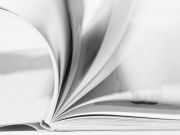Illuminating History: A Retrospective of Seven Decades, Bernard Bailyn, W. W. Norton & Company, 2020, 270 pp., $28.95 hardbound.
Robert L. Paquette is a prize-winning historian and co-founder of the Alexander Hamilton Institute for the Study of Western Civilization, 21 W. Park Row, Clinton, N.Y. 13323; [email protected]. He has taught at Hamilton College for thirty-seven years, where he held the Publius Virgilius Rogers Chair in American History for seventeen years until January 2011, when he resigned the title in protest of the educational direction of the college.His most recent book is The Denmark Vesey Affair: A Documentary History (2017).
Bernard Bailyn died at the age of ninety-seven, four months after publication of this captivating curio of a book, part autobiography, part meditation, part history, and part historiography. Once discharged from the army at the end of World War II and settled into the discipline of history at Harvard University, Bailyn undertook an ambitious quest to understand nothing less than the structures, forces, and ideas that ushered in the modern world. During the zigs and zags of a long and distinguished career, he emerged as one of the foremost interpreters of the founding of the United States. He won the Pulitzer Prize in history twice: in 1968 for The Ideological Origins of the American Revolution and in 1987 for Voyagers to the West, one of several volumes he devoted to the rising field of Atlantic history. Though Bailyn illuminated better than most scholars the contours of seventeenth- and eighteenth-century American history, his final book hints at his growing concern about the rampant opportunism and pernicious theoretical faddishness that was corrupting the discipline he loved and to which he had committed his professional life.
Illuminating History consists of five chapters. Each serves as kind of a scenic overlook during episodes of a lengthy intellectual journey. At each stop, Bailyn brings to the fore little known documents or an obscure person’s life to open up views into a larger, more complicated universe, which he had tackled with greater depth and detail in previously published books and articles. A fourteen-page epilogue contains passages that he extracted from prior publications to best communicate his “understanding of the nature of history and of some of the problems of studying and writing about it.” Historical genius, he insisted, remained inextricably linked to a narration in which the author demonstrated the very rare “capacity to project, like a novelist, a nonexistent, an impalpable world in all its living comprehension, and yet to do this within the constraints of verifiable facts.”
Bailyn’s concluding appendix pays tribute to the two most important historians who influenced him at Harvard: Samuel Eliot Morison and Oscar Handlin. The blue-blooded Admiral stood as an imposing institution unto himself, aloof yet awe inspiring in habit, manner, and productivity. Bailyn calls the Brooklyn-born Handlin, the son of Russian Jewish émigrés, “the most influential and creative historian of American social life in the second half of the twentieth century.” He, far more than Morison, who was Bailyn’s initial graduate adviser, mentored Bailyn and supervised to completion his dissertation on seventeenth-century New England merchants. From Handlin, author of a multivolume study of liberty, Bailyn learned, it appears, a great deal about its preciousness and fragility in American life, a theme that surfaces again and again in Bailyn’s own work.
Like Max Weber, Bailyn had an abiding interest in the religious sources of capitalist development. In chapter one, he returns to the life of Robert Keayne, a conflicted soul trying to justify himself near the end of his life in mid-seventeenth-century New England to both God and his fellow Puritans. Three years before his death, Keayne composed a 48,000-word apologia dressed as a last will and testament, which Bailyn had pored over in several publications during the early part of his career. In the will, Keayne attempted at length to justify his behavior. For Bailyn, the document revealed a dynamic at work, how Puritanism’s seeming constraints on acquisitiveness could serve to incentivize behavior that ultimately challenged core beliefs. The will offered an unusually rich source into the vision of order of a prosperous, micro-managing merchant, prone to back-sliding, who was both praised and vilified by his neighbors for behavior that sought to reconcile the demands of Calvinist piety with the lure of worldly money-making.
Bailyn spent several years teaching in Harvard’s school of education. Reading Werner Jaeger’s monumental three-volume study of Greek ideals and culture caused him to ponder the idea of paideia— in essence, the education necessary to allow the lineaments of a culture to survive from generation to generation—and how it could be applied to Elizabethan institutions transferred to the colonial North American mainland. Necessarily, he examined the crucial site of informal schooling: the colonial family. His findings on the patrimonial household led him into a lively debate, with international repercussions, described in chapter two, with the British historian Peter Laslett on family structure and the pervasiveness of extended or stem families in various societies. Bailyn’s influence contributed to a flurry of microcosmic studies of colonial New England villages. Seminal research by one of Bailyn’s graduate students, Philip Greven, of four generations of families in colonial Andover, Massachusetts, underscored just how important the ownership and distribution of land was to the maintenance of family structure.
In preparing for publication a collection of pamphlets composed during the revolutionary period, Bailyn encountered an unanticipated abundance of hundreds of writings, the majority of which attempted to explain why the colonists had revolted. For Bailyn, this literature, when examined as a whole, bespoke a coherent, articulated world view, which borrowed heavily from the radical Whig critique of the exercise of arbitrary power by an allegedly corrupt Court Party in late seventeenth-century and early eighteenth-century England. Bailyn elaborated on this theme in the Ideological Origins of the American Revolution, his most renowned book. Chapter three of Illuminating History appears to respond to critics who found the book too focused on elites and neglectful of how ordinary folk received elite ideas while offering variations of their own. Bailyn calls on Habottle Doyle, Jr., a Boston shopkeeper; the Reverend Stephen Johnson, an “ordinary preacher” from Lyme Connecticut; and the citizens of tiny Petersham in central Massachusetts to demonstrate the revolution’s widely shared values and how thoughtful and deeply engaged were commoners in their turbulent times. The ideas that incited revolutionary fervor across class lines “were not derived either from systematic, formal discourses or from crass-self-interest.” In the midst of crises brought on by the Stamp Act and Quartering Act, the agitated Doyle kept up several years of running commentary in the form of inked insertions into Boston newspapers as if to explain to the world what the colonists were fighting for. The Reverend Johnson's writings and sermons, also at the time of the Stamp Act, suggest how political cris de coeur were elevated to holy cause by sympathetic, visionary ministers. A draft state constitution sent out for commentary to towns and villages throughout Massachusetts in 1780 elicited a treasure trove of critical responses from non-elites into which Bailyn tapped. Those from Petersham, a town in central Massachusetts that would become a breeding ground for Daniel Shay’s rebellion, presented the most comprehensive populist critique of the proposed constitution on a wide range of the most searing liberty-related issues of the day.
Bailyn thanked the army for forcing on him the study of German, a language that allowed him as a historian to more fully appreciate the contributions of the many German-speakers who peopled America. At the time of the Revolution, they comprised about one-third of the population of Pennsylvania. The New World attracted dreamers, seekers, and utopians of all sorts, and in chapter four Bailyn singles out for revisiting Johann Conrad Beissel, a charismatic journeyman baker from the Palatinate who before the outbreak of the Revolution carved out of the woods near Philadelphia a perfectionist community in anticipation of the Second Coming. Although Beissel’s quirky regimen subjected his followers to celibacy and hunger, his genius, allowed to fire in a land of religious freedom, reinvented the art of book illumination and composed choral music so elevating and spellbinding that it attracted international commentary.
Early in his career, Bailyn aspired to write a history of the Atlantic world that favorably compared in scope and erudition to Fernand Braudel’s multivolume history of the Mediterranean world. The end of World II brought programs and alliances that encouraged Bailyn and other scholars to pursue Atlantic history, a “world in motion,” as a justifiable category of historical analysis. Although he did not pioneer a graduate program aimed at studying the dynamic post-Columbian Atlantic complex, which incorporated within it the Atlantic slave trade, he did run, beginning in 1995, almost two decades’ worth of Atlantic history seminars that gathered younger scholars from all over the world to explore central themes. In chapter five, Bailyn reflects on that experience, which included the unsettling yet exciting discovery that subjects he thought he knew rather well, he really misunderstood or understood only superficially. Competition between imperial powers bred warfare, which became endemic to the Atlantic world in the seventeenth and eighteenth centuries. Emerging nations had common problems demarcating boundaries of sovereignty, citizenship, and community. Intercultural encounters often had surprise endings. Rulers, understanding the limits of their own power, survived more by negotiation with subordinate groups and persons than trying to impose their will by brute force. Almost thirty volumes of essays emerged from Bailyn’s seminars.
Bailyn never kept a personal diary. Although he wrote an impressive biography of Thomas Hutchison, the last royal governor of Massachusetts, he resisted the genre because of the problem of almost involuntary intellectual slippage. “[T]he authorial stance can get confused.” he pointed out. “The voices tend to merge.” One senses from this volume that Bailyn also resisted calls for him to write an autobiography. For Bailyn history was a demanding craft. Historians, he thought, must at bottom be honest storytellers. In the practice of history, he concluded, one “assume[s] that the reality of the past can be subjected to useful inquiries, that among the responses to those inquiries some views can be shown to be more accurate depictions of what actually happened than others, and that the establishment, in some significant degree, of a realistic understanding of the past, free of myths, wish fulfillments, and partisan delusions, is essential for social sanity.” With that most useful tidbit, a great historian has left us.
Image: Daderot., Wikimedia Commons, Creative Commons Attribution-Share Alike 3.0 Unported license, cropped.
Recommended citation: Robert L. Paquette. "Bernard Bailyn: An Historian to Learn From.” Academic Questions 34, no. 1 (Spring 2021): Page 141–Page 145.














